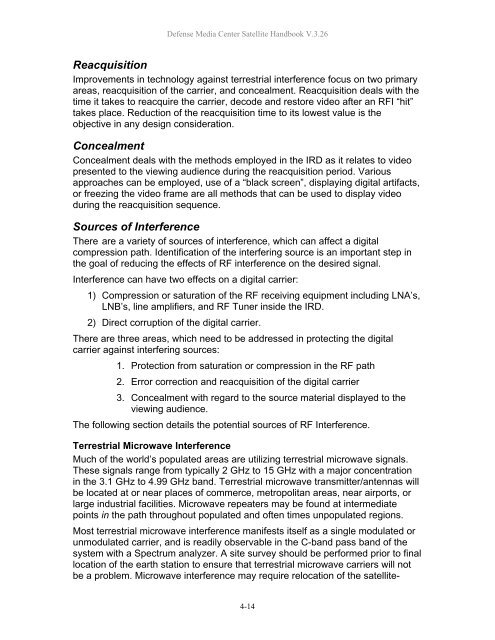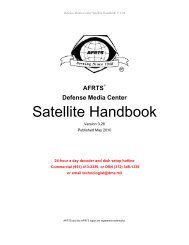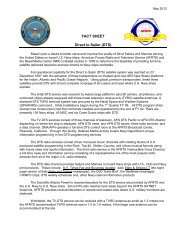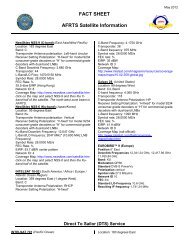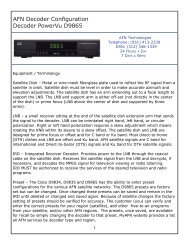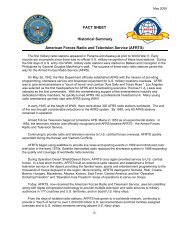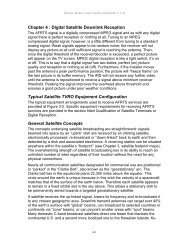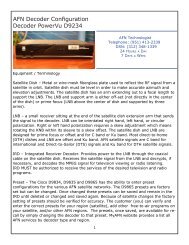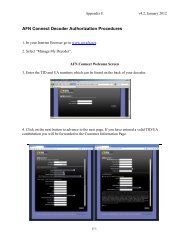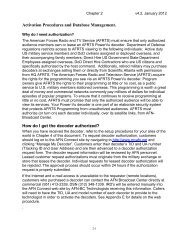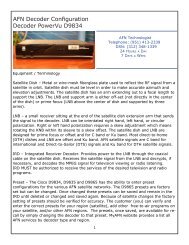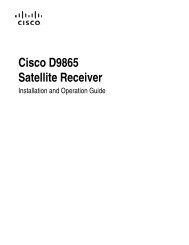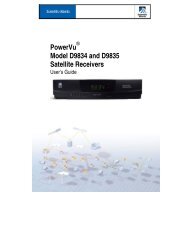AFRTS Defense Media Center Satellite Handbook
AFRTS Defense Media Center Satellite Handbook
AFRTS Defense Media Center Satellite Handbook
You also want an ePaper? Increase the reach of your titles
YUMPU automatically turns print PDFs into web optimized ePapers that Google loves.
<strong>Defense</strong> <strong>Media</strong> <strong>Center</strong> <strong>Satellite</strong> <strong>Handbook</strong> V.3.26<br />
Reacquisition<br />
Improvements in technology against terrestrial interference focus on two primary<br />
areas, reacquisition of the carrier, and concealment. Reacquisition deals with the<br />
time it takes to reacquire the carrier, decode and restore video after an RFI “hit”<br />
takes place. Reduction of the reacquisition time to its lowest value is the<br />
objective in any design consideration.<br />
Concealment<br />
Concealment deals with the methods employed in the IRD as it relates to video<br />
presented to the viewing audience during the reacquisition period. Various<br />
approaches can be employed, use of a “black screen”, displaying digital artifacts,<br />
or freezing the video frame are all methods that can be used to display video<br />
during the reacquisition sequence.<br />
Sources of Interference<br />
There are a variety of sources of interference, which can affect a digital<br />
compression path. Identification of the interfering source is an important step in<br />
the goal of reducing the effects of RF interference on the desired signal.<br />
Interference can have two effects on a digital carrier:<br />
1) Compression or saturation of the RF receiving equipment including LNA’s,<br />
LNB’s, line amplifiers, and RF Tuner inside the IRD.<br />
2) Direct corruption of the digital carrier.<br />
There are three areas, which need to be addressed in protecting the digital<br />
carrier against interfering sources:<br />
1. Protection from saturation or compression in the RF path<br />
2. Error correction and reacquisition of the digital carrier<br />
3. Concealment with regard to the source material displayed to the<br />
viewing audience.<br />
The following section details the potential sources of RF Interference.<br />
Terrestrial Microwave Interference<br />
Much of the world’s populated areas are utilizing terrestrial microwave signals.<br />
These signals range from typically 2 GHz to 15 GHz with a major concentration<br />
in the 3.1 GHz to 4.99 GHz band. Terrestrial microwave transmitter/antennas will<br />
be located at or near places of commerce, metropolitan areas, near airports, or<br />
large industrial facilities. Microwave repeaters may be found at intermediate<br />
points in the path throughout populated and often times unpopulated regions.<br />
Most terrestrial microwave interference manifests itself as a single modulated or<br />
unmodulated carrier, and is readily observable in the C-band pass band of the<br />
system with a Spectrum analyzer. A site survey should be performed prior to final<br />
location of the earth station to ensure that terrestrial microwave carriers will not<br />
be a problem. Microwave interference may require relocation of the satellite-<br />
4-14


